ISSN 2410-5708 / e-ISSN 2313-7215
Year 8 | No. 23 | p. 102 - 122 | October 2019 - January 2020
© Copyright (2020). National Autonomous University of Nicaragua, Managua.
This document is under a Creative Commons
Attribution-NonCommercial-NoDerivs 4.0 International licence.
Structure mistakes in the adjective subordinate sentence when writing the argumentative essay
https://doi.org/10.5377/torreon.v8i23.9524
Submitted on August 20th, 2019 / Accepted on November 20th, 2020
Keywords: mistakes, grammar, composition, subordinate adjective, argumentative essay
Abstract
The writing of the argumentative essay is approached in the present work, identifying the difficulties experienced for the first year students of the Language and Literature career. In addition, the effects of not using the stages of the composition with relevance. The work starts from the objective of validating a didactic project on the use of the adjective subordinate clause as a mechanism of thematic progression in the argumentative essay.
The methodology implemented in this investigation begins with the analysis of the diagnostic test. In it, shortcomings in grammatical knowledge were detected, especially in the subordinate adjective sentence. This was accompanied by observation guide, survey and interview applied to selected students. The results showed that students have difficulties expressing themselves when writing. Partly due to the lack of separation of the teaching of grammar with written expression. Therefore, in the construction of ideas this textual property is not fulfilled.
Introduction
The present work focuses on written expression. Directly in the writing of the argumentative essay and in the functionality of grammar for the acquisition of this macro ability, as is the adjective subordinate sentence. This approach originates from a diagnostic test applied to first year students of the Law major in 2015 and the reflection made on the functionality of grammar for Spanish users. This promoted the search for works related to the two themes.
However, the findings showed concern about the difficulties in students mastering written expression. All of them made general statements about the problem, the measures of solution and within their conclusions they stated that the teacher is the one to develop skills in the student and writing is one of them. On the other hand, none of the theses and articles consulted considered retaking grammar and written expression in their studies in an integrated manner. Therefore, it is an innovative study, because it combines the subordinate adjective sentence as a mechanism of thematic progression in the writing of the argumentative essay.
Therefore, the importance of this work lies in finding the solution to writing problems from an applied grammar, functional and useful for the student. With the sense that the student associates his scriptural difficulties with the lack of theoretical and practical mastery of grammar knowledge. Therefore, the main objective of this research work is to validate in the writing of the argumentative essay, the use of the adjective subordinate sentence as a mechanism of thematic progression. In a timely manner, this first article contains the results related to the first specific objective of the research that consists in describing the difficulties of the first year students of the Language and Literature major in the use of grammar schemes in the written production of a diagnostic text of argumentative type.
Supporting statement
The theory that supports the work is primarily related to the psychology of learning. This is the starting or arrival point of every teacher. In addition, it is this that must take care of the process that each student puts into practice (Rodríguez and Moreira 2002). Therefore, this leads to a redefinition of the teaching process, considering making learning effective. In this sense, learning is not formed by simply transmitting knowledge or storing it. (Chadwick, 1999).
On the other hand, it is real that the human being lives in the process of growth and learning, the second is the first modifier of behavior and knowledge. In this regard Piaget (s.f.) states that “the conception of a plastic organism, constantly modified by learning, by outside influences, by exercise or” experience “in the empiricist sense of the word” (p. 43). It is clear that the student lives a constant process in the classroom, but this is only effective if the student receives adequate attention using proactive learning strategies, which would positively modify the student.
Therefore, the constructivist approach is assumed, because learning must be the product of a process experienced by the student. An important question in this reflection, as a starting point, what is constructivism, for Hernández (2008) “Constructivist theory focuses on the construction of knowledge through activities based on rich experiences in context” (p.1). It is the activities that enrich the students, which give them experience. If these are taken from real context situations. These would have true learning or be the builders of their knowledge. Therefore, the theory takes into account the communicative approach, because the student must master his language system and also be able to use it in context effectively (Luzon and Soria 1999).
In that sense, for education to achieve its effectiveness it must have a design of learning strategies. Viva (2010) defines them “as any activity or set of activities that enable learning and self-control by the person who learns” (p. 2). It is important to note that the guarantee of education will depend largely on the set of activities that are part of the strategy developed for this purpose. At present, they are both the strategy models that can be consulted, or there is even the possibility that the teacher designs their own strategy according to their educational situation and characteristics of the group of students.
The writing product sought is the writing of the argumentative essay. But what is the argumentative essay. Torres (2004) expresses that “The argumentative essay can be defined as a type of structured and unified text around a thesis that is supported in various ways as reasons or illustrations” (p. 98-99). Orally, the human being lives by arguing, defending a position, however, in writing it fails to specify coherent ideas that reinforce its point of view. An important aspect is that the writing is resumed procedurally. This begins to be achieved when the person takes steps in the mental draft including the process and the content of the text. (Meneses, Mata and Ravelo, 2007).
Finally, the adjective subordinate sentence and is from the Manual of the new grammar (2010) “Subordinate sentences of relative (also relative or simply relative sentences) are called those headed by a pronoun, adverb or relative determinant, or by syntactic groups that these voices form” (p. 836). In this sense, today it is called the relative subordinate sentence that is introduced by the relative: that, which, who, whose, whose. It is understood that it is practical, but for the student it is a complex process, because it cannot insert it into the sentence, which represents the idea in the paragraph.
In that sense, the utility of subordination in written expression is based on the premise of expanding the main idea. For his part, Giammatteo (2013) states that “This idea of continuity is accentuated with the subordinate” (p. 12). Every person who masters its mother tongue must know the benefit of the use of subordination in their writings and master its construction, because that way it will guarantee to express itself fluently both orally and in writing. Rodríguez (2012) observes that it is necessary to do a work in greater depth in the teaching of grammar, to account for the phenomena of construction of a grammatical object, especially subordinate sentence.
Materials and methods
The paradigm with which the present investigation was worked is the socio-critical one, because it proposes dynamism to this process. In addition, it is essential that the teacher could be an active part of the research that is included in practice and with theory. It is the conscious way to generate an investigation from within the problem to solve it. The type of research that was carried out is the so-called action research. In that sense, the teacher from its practice realizes, adjusts and innovates strategies that allow to leave the traditional schemes, in order to solve the problems existing in classrooms that hinder the development of the student.
The approach used to conduct the research was the qualitative one. This allowed from the beginning of the process, the descriptions of the phenomenon on all the elements involved in written production. In addition, quantitative techniques were used, which served an auxiliary function, to present the reality of the phenomenon. Through the application of the case study approach, an organization of the information obtained is carried out, on a unitary basis, because it is from this point that individual works can be analyzed as a whole (Arzaluz, 2005).
The population for this study was the first-year students of the Hispanic Language and Literature career of the Professionalization courses (Saturday program) of UNAN-Managua, because they will be secondary school teachers in the future. Therefore, participation in the implementation of the strategy formed awareness in the art of writing.
The instrument used was the wording of the diagnostic argumentative text, through which the problems faced by students in written production were detected, especially in the writing of the argumentative essay. In addition, it was confirmed that students have some grammatical deficiencies, which interfere with their written expression. Another was the observation guide for students during the writing of the argumentative diagnostic text. Therefore, it is a way of being face to face with the incidents in the classroom, with the problem and its contributions, which will be included in the analysis of the data.
Results and Discussion
In a first approach to grammar knowledge, two fundamental aspects were consulted through the checklist:

The first aspect refers to the use of grammar in writing. In the graphic No. 7, the “No” box, shows impressive percentages, female 47%, public 36% and urban 50%, ensure that the grammar was not used in the written diagnostic text. This aspect is basic for this investigation. With the previous question they were asked about the importance of grammar for the writing of the text, but with the answer it is inferred that they do not connect grammar knowledge with written production and do not recognize its influence.
Students, organized according to the variables, consider not using grammar to write. They do not recognize, that this gives them the knowledge about their mother tongue and the possibility of structuring ideas in a cohesive and coherent way.
The second aspect is a reflection: they could write without grammar. Figure 7 shows that the “Yes” box shows notable percentages (male 40%, public 33% and rural 60%). This reaffirms the ignorance of the use of grammar in writing. The percentages express that without the grammatical theory the argumentative diagnostic text could be written. It is a reality, there is a decoupling between grammar teaching and written expression. Because in high school, structural grammar is taught, basically for the syntactic analysis of isolated sentences.
With the information obtained through the checklist (graph Nº 7). You have a first approach to the student and his grammatical knowledge. The latter are formed with academic studies, this in turn is transformed into cognitive schemes, which ultimately translate into competencies. But, if that process does not occur, the results are catastrophic.
The first category addressed in graphs Nº 8, 9 and 10, is related to the use of the simple statement. The percentages are high: female 75%, private 83% and urban 82%, who indicate using it in writing:
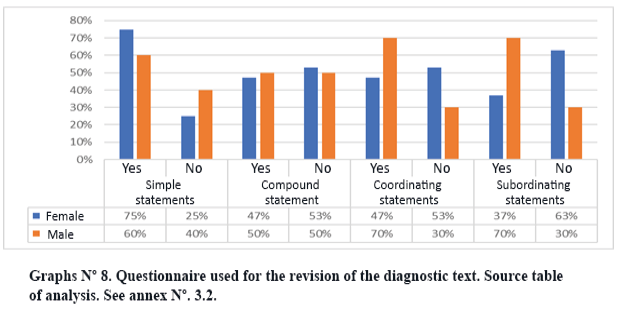
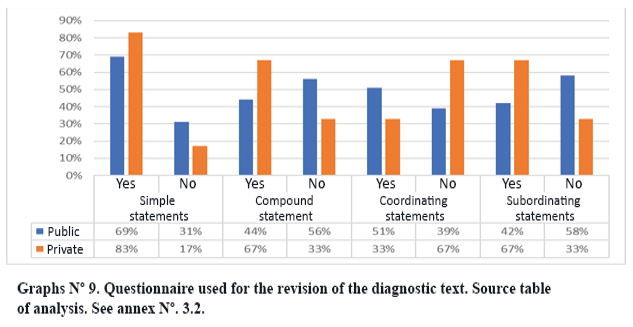
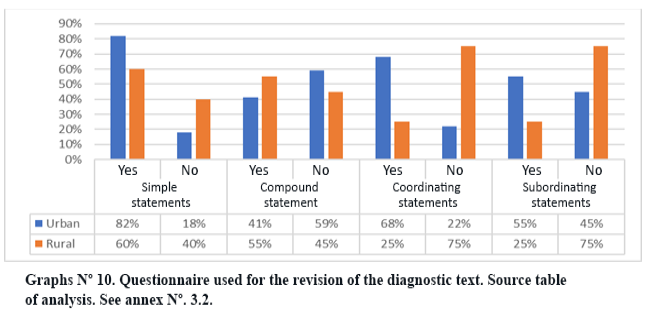
The texts TDA9 and TDA16, show a different reality from that indicated in graphs N° 8, 9 and 10. Both are examples of statements, but not simple, because they have more than one conjugated verbal form and grammatical theory (Manual of the new grammar, 2008) indicates that the simple statement is constructed with a conjugated verbal form. This is more than evident, the students confuse the simple statement with the compound.
Therefore, it can be said that the percentage expressed in the “Yes” box (male 50%, private 67% and rural 55%), of the second category of graphs Nº 8, 9 and 10 is correct. But, with the result of the analysis of the texts TDA9 and TDA16, this is below reality, because the statement with the greatest presence in the diagnostic texts is the compound statement
The third category shown in graphs No. 8, 9 and 10, is related to the use of coordinating statement. This shows results in the “Yes” box, which mark a clear division: the female (47%), private (33%) and rural (25%) groups have a low percentage of use, while the male groups (50%), public (51%) and urban (68%) high percentage of use of coordinating statement. This partition reflected in the grammatical knowledge about the types of compound statements is interesting, because there are no criteria of unity around this knowledge.
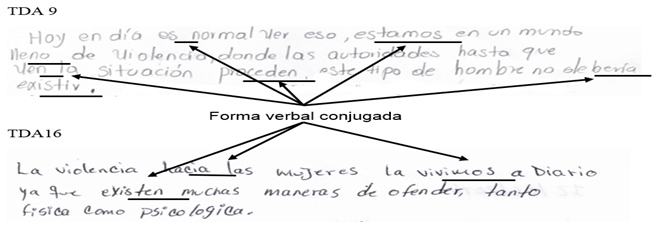
However, the answer is one aspect, the other aspect is completed with the review. In the texts TDA21 and TDA23 this particularity is observed. In the first, the absence of the coordinating statement and in the second the presence of it. It is in the latter, it can be seen that the coordination is copulative, built with the “y” nexus. According to the new grammar, homocategory coordination occurs when there is coordination of elements of the same syntactic level, but this type of coordination does not occur in the text.
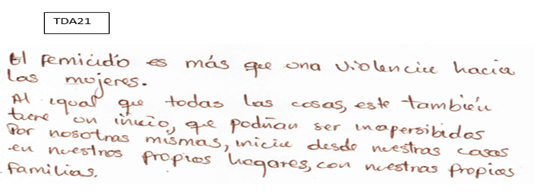
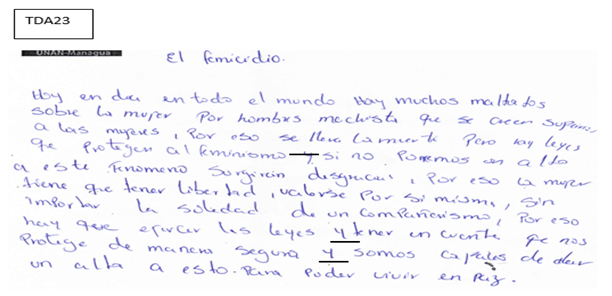
The last category present in graphs Nº 8, 9 and 10 addresses an important element for this investigation, this is the one referring to the subordinate sentence. The percentages reflected in the male variable 70%, private 67% and urban 55% claim to have used this type of compound sentence. The results are encouraging, because students in theory know about the sentence mentioned.
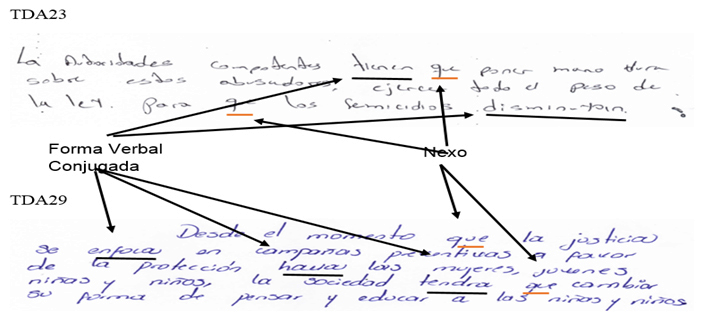
In texts TDA23 and TDA29, the presence of the subordinate sentence is identified. First, because the statement identifies more than one conjugated verbal form; second, the use of the relative “what.” These two elements are basic to the existence of a compound, subordinate type sentence. One aspect to note is that this type of structure is present in most diagnostic texts. However, the students failed to affirm in their entirety the presence of this type of sentence in the writing.
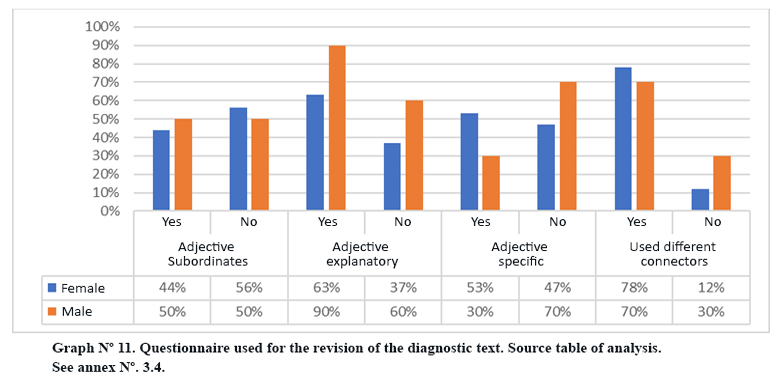
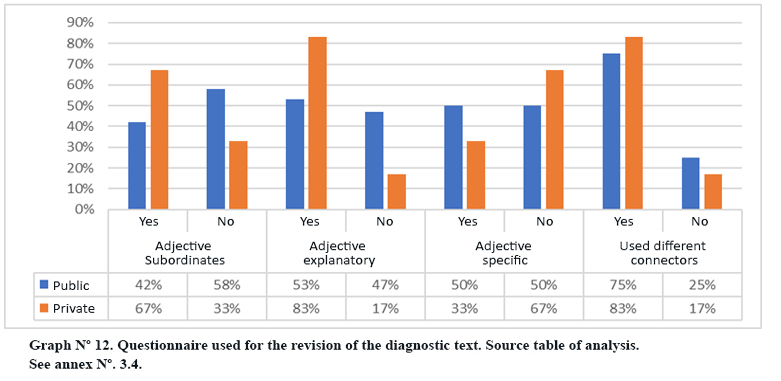
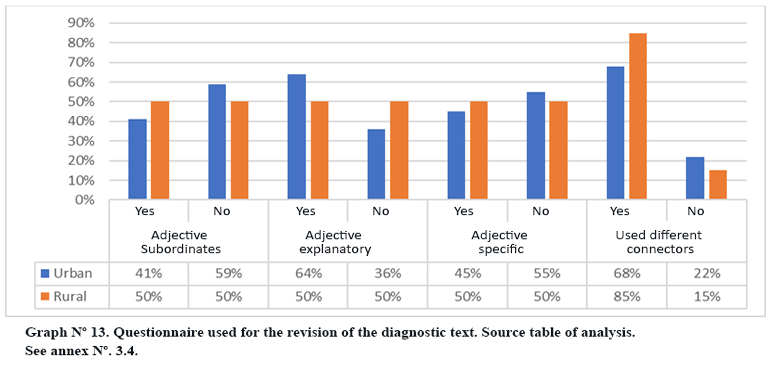
The information contained in graphs Nº 11, 12 and 13, it is important for this study: the adjective subordinate sentence. This was built with the contributions of the questionnaire (survey). The affirmation percentages of the 50% male, 67% private and 50% rural variables are at the middle level, therefore, the denial percentage has similar results. This indicates that the students had not properly appropriated this knowledge, because there is no positive evidence in their answers.
In the second and third aspects of graphs No. 11, 12 and 13, they were asked about the type of subordinate sentence used in the writing of the diagnostic text. The percentages of “Yes” for the second: male 90%, private 83% and urban 64%; in the third female 53%, public 50% and rural 50%. The above indicates that the sample is divided, the first group of percentages ensures that the subordinate adjective is explanatory and the second adjective specific. The students answered this questionnaire using their previous knowledge, which is why the existence of these answers,
The last aspect consulted in the questionnaire and presented in graphs No. 11, 12 and 13, is related to the use of different links to insert the adjective subordinate sentence. The students were asked if they used the following links: what, which, where, when and who. The female variables 78%, private 83% and rural 85%, indicate that students were convinced to use these links to insert the adjective subordinate. However, in the cases analyzed, it is evidenced that the most commonly used is “what” and rarely “which”.





The four aspects addressed in graphs 11, 12 and 13 will be observed in selected texts of the sample. In texts TDA13, TDA42, TDA1, TDA3 and TDA6, the situations related to graphs 11, 12 and 13 are explained. The first is the use of the adjective subordinate in the diagnostic text; In the examples, the use of the subordinate, which dominates the writing, is observed, but this is not reflected in the percentage of the graphics.
The second and third aspects refer to the type of adjective subordinate used in the argumentative diagnostic text. In the graphs already mentioned, the percentages have a balance, between the explanatory and the specificative. However, in the two examples texts (TDA13, TDA42, TDA1, TDA3 and TDA6), the type of subordinate used in the writings are of a specific type. In addition, it was found in other texts that the use of subordinate explanatory adjective was minimal.
The fourth aspect addressed in graphs 11, 12 and 13, is related to the link used to insert the adjective subordinate. The students indicated using a variety, but in the example texts TDA13, TDA42, TDA1, TDA3 and TDA6 the connector used is “que”. This type of link is present in most of the analyzed cases and there was no use of various links, as the students established in the questionnaire.
A detailed analysis of the adjective subordinate sentence present in the diagnostic text was carried out, of which the difficulties in the adjective subordinate syntactic schemes would be established. This allowed to determine the errors in the construction of the adjective subordinate sentence of type: explanatory or specific, which limit the progression of ideas in the text.
With the result, a graph was constructed, which reflects the percentages that indicate the errors in the use of the adjective subordinate present in the texts:

Figure 14 shows a quantifiable summary of the number of students who failed to use the adjective subordinate sentence: explanatory and specific. The percentages in the errors shown in the use of the specific subordinate are the highest. This type of sentence is the most used in the texts. The students do not know the explanatory. This is a limitation for the students, who do not know in a practical way the use of this linguistic resource, proposed by the grammar.
With the result a graph was constructed, which reflects the percentages that indicate the errors in the use of the subordinate adjective present in the texts:
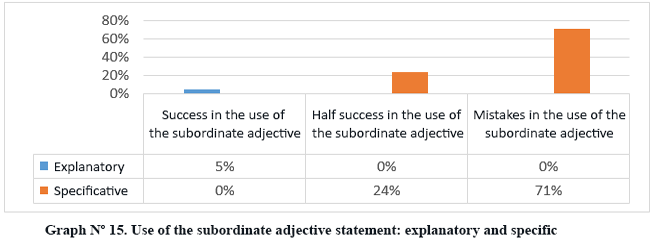
Graph Nº 15 shows the result on the use of the adjective subordinate. The first category presents the successes in the use of the adjective subordinate, according to the types. In that sense, the adjective subordinate of explanatory type is the one that presents 5% of success. An interesting fact, because it is the one that has less use and is the one of successful registration. On the other hand, the medium and incorrect successes occurred in the adjective subordinate of the specific type, besides, this is the frequent.
Different texts will be used to show what is presented in graph Nº 15. The first aspect of interest is to present the successes in the use of the adjective subordinate. The parameters established in the categorical system were used for the analysis:
The text TDA 21 is an example of the success in the use of the adjective subordinate, by the student. In it, the subordinate of the explanatory type is identified, which was inserted by means of the simple “what” nexus, and the use of the comma also indicates its presence. It is described as successful by the fact that it has a history and consequent. Among them, it has a syntactic function and maintains an anaphoric relationship. However, the wording presents redundancy of ideas due to the repetition of the word inicio and lack of agreement with the consequent (inicie).
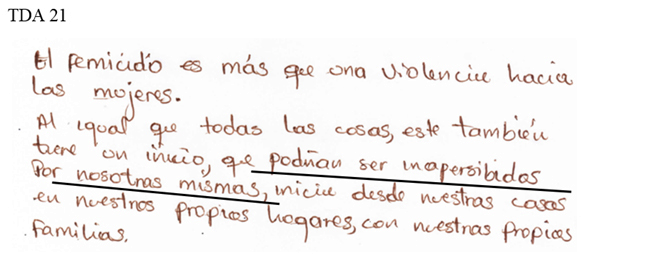
In the paragraph taken from text TDA42, the use of the relative “what”, “what” and “which” is observed. These fulfill the function of introducing the adjective subordinate. The first, inserts an adjective of an explanatory type, which contains additional information and contributes to the progression of ideas. The second, inserts an adjective of a specific type and complies with the relationship between the antecedent and the consequent. But, in the third sentence there is a mismatch between the link and the consequent. This causes the separation between the ideas, which contributes to create a disjointed text, therefore the thematic progression will not occur.
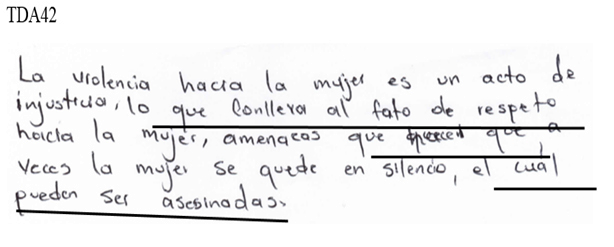
In the text, whose code is TDA 32, the use of the simple relative “what” is identified. This inserts a subordinate of explanatory type. The error occurs, because in itself the information of the subordinate is related to the antecedent, but not to the consequent. The sentences in the paragraph lack coherence, therefore, the separation of ideas affects the unity of the text. This shows that students have ideas to present in the text, which they fail to achieve in coherent and cohesive ideas, because they do not order the ideas in sentences and are linked through connectors.
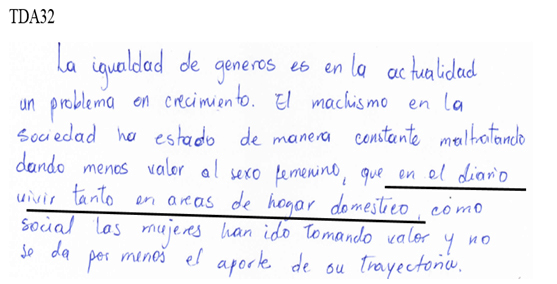
In the TDA 1 text, the use of the specific adjective subordinate is identified. This sentence was introduced through the simple “what” nexus; but, the error arises between the subordinate and the consequent, because the relationship called anaphoric is broken between them. Therefore, coherence between ideas is affected.

In the text TDA6 the use of the specific adjective subordinate is present. Introduced by the simple “what” nexus, it is directly related to the antecedent, but not to the consequent one. This is, of course, due to the poor mastery of grammar, which influences from the construction of sentences to the use of punctuation marks.
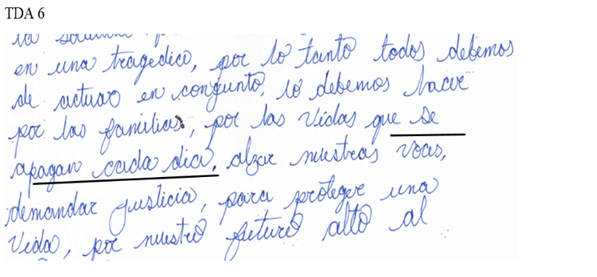
This knowledge is formed throughout academic life (primary-secondary school). Product of the little theoretical-practical domain formed at that stage of life, problems have proliferated in students, which are manifested in writing. Therefore, the student must consciously acquire the use and management of the elements of its native language, for its application in different contexts.
In the text TDA 13, the use of the specific subordinate adjective sentence is analyzed. This was inserted by the simple relative “what”; but, in the paragraph there was an abuse of the link, it does not allow an adequate progression of ideas.
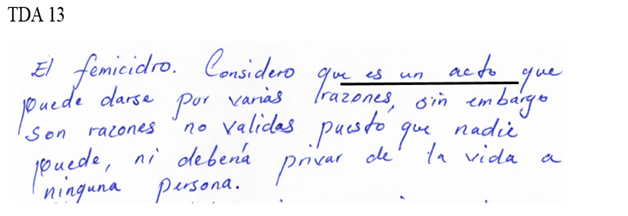
Text TDA 29 shows the difficulties faced by its writer. These begin in the subject (justice), on which all the action of the paragraph falls. The conjugated verbal forms (focus, towards, will) used in the writing do not favor the writing of ideas. On the other hand, the use of the adjective subordinate of a specific type is detected, which is introduced by the “what” nexus. The mistake in the construction consists in the lack of relationship between the antecedent, the nexus and the consequent one.

In the TDA48 text, the disorder in the construction of ideas does not favor the transmission of information. This problem arises from the use of oral language syntax in writing. That contributes to the mistakes in the adjective subordinate. Because the writing structures are the product of the meditation process, instead those of the oral language are spontaneous. The last is the obvious in the text, which causes the errors of the adjective subordinate, because there is no relationship with the consequent.
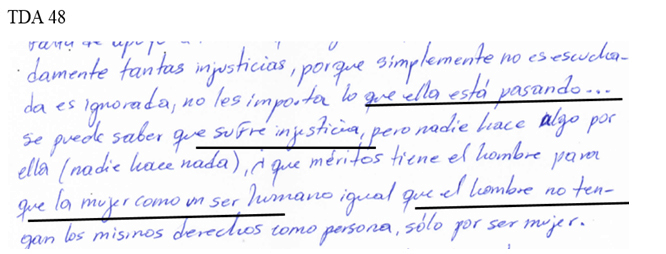
This mistake is exacerbated, because it cannot be noticed where the sentence finishes. The student built a chain of compound sentences. Therefore, when reviewing the immediate antecedent of each subordinate sentence, it is appreciated that the relationship between them is not well established and, in addition, when the connection with the antecedent is lost, it is also lost with the consequent one.
In the text (ADD 32), the use of a subordinate construction is observed. At first glance, it seems to be an explanatory adjective subordinate sentence. However, the most outstanding detail is that when observing its construction in detail, it is appreciated that the conjugated verbal form does not match the antecedent in number and person. That is, the sentence is introduced, but it has a matching error. This anomaly is the cause of errors in two ways: in the structure of the subordinate and in the coherence of the paragraph. But really the subordinates identified are of the direct object type.
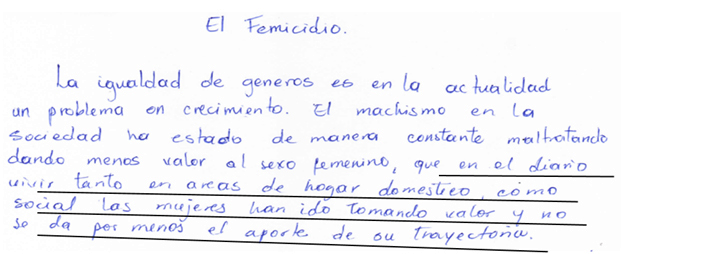
The TDA42 text shows the use of the “what” and “which” links. The two correspond to the use of complicated relatives in the construction of the adjective subordinate. The difficulties lie in the fact that they effectively introduce an adjective subordinate of an explanatory type with the “what” nexus, but, within this same place, another specific subordinate (which makes). This fault is known as queísmo. Therefore, the ideal structure of the subordinate is not met. With the “which” link, it happens that there is no agreement of person and number with the antecedent.

In summary, the text presents propositions linked by commas, but they do not comply with the structure of a subordinate adjective explanatory sentence, neither the first nor the second. This seems to be the product of the influence of the oral language. Clearly this construction used in the previous text (TDA42) does not fulfill the indicated function. Therefore, it does not contribute to a restriction, specifying the denotation of the nominal group to which it belongs.
The TDA3 text shows the repetion of the use of the simple relative "that", in the attemp to elaborate a paragraph, without using the suitable form for the construction of the specific adjective subordinate sentence. Therefore, the failures focus on the lack of relationship between the antecedent, nexus and the consequent, each acting as independant elements within the paragraph, avoiding the hierarchy between ideas and thematic progression.
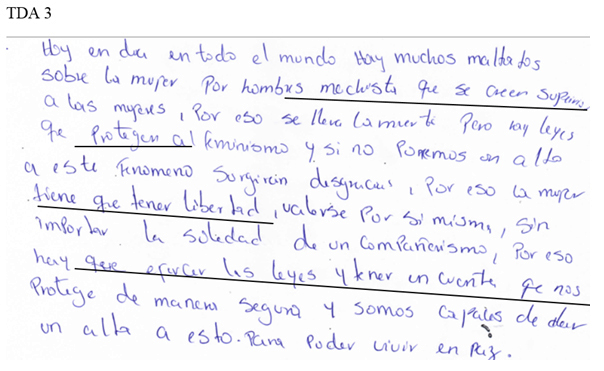
The benefits of using grammar are countless, as is its presence in written expression. But, the lack of mastery of the theory and the inability of the students to use it in practice, prevents them from developing their full potential. Therefore, it is the time for the corresponding institutions and instances to assume a more belligerent role in teaching written expression.
Conclusion
The students proved to be unaware of the importance of grammar for writing, because about 50% said they were not present in the writing and a similar percentage said they did not use it to write any text. In the aspect of the adjective subordinate sentence, it was found that the one with the greatest use is the specific one and the simple nexus “that”, these are the ones with the greatest presence in the diagnostic texts. On the other hand, the subordinate explanatory adjective and the complex links are those that have less presence in the texts. Therefore, it can be affirmed that, in the argumentative diagnostic text, errors were found in a high percentage in the construction of adjective subordinate sentences (both types). Finally, the analysis was done considering different variables: sex (female-male), center of origin (public-private) and place of origin (urban-rural), however, all presented the same difficulties in mastering the process of composition and mistakes in the construction of the subordinate adjective.
References
Arzaluz, S. (2005). La utilización del estudio de caso en el análisis local. El Colegio de Sonora. México. Retrieved from: http://www.redalyc.org/articulo.oa?id=10203204
Chadwick, C. (1999). La psicología del aprendizaje desde el enfoque constructivista. Revista Latinoamericana de Psicología, vol. 31, núm. 3 pp. 463-47 Fundación Universitaria Konrad Lorenz Bogotá, Colombia. Retrieved from: http://www.redalyc.org/pdf/805/80531303.pdf
Giammatteo, M. (2013) “¿Por qué y para qué enseñar gramática? La gramática en la formación de habilidades cognitivo-lingüísticas”, SIGNOS ELE, 7, diciembre 2013, URL http://p3.usal.edu.ar/index.php/ele/article/view/2003, 16 págs.
Hernández, S. (2008). El modelo constructivista con las nuevas tecnologías: aplicado en el proceso de aprendizaje. En: Comunicación y construcción del conocimiento en el nuevo espacio tecnológico [monográfico en línea]. Revista de Universidad y Sociedad del Conocimiento (RUSC). Vol. 5, n.º 2. UOC. [Retrieved from: 20/10/2015]. http://dialnet.unirioja.es/servlet/articulo?codigo=2799725
Luzón, J. y Soría, I. (1999). El Enfoque Comunicativo en la Enseñanza de Lenguas. Un Desafío para los Sistemas de Enseñanza y Aprendizaje Abiertos y a Distancia. Instituto Cervantes (España)
Meneses Báez, A. L., Mata, F. S., & Ravelo Contreras, E. L. (2007). Description of cognitive processes involved in essay-writing. Acta Colombiana de Psicología, 10(1), 83-98.
Nueva gramática de la lengua española (2010). Asociación de academias de la lengua española.
Piaget, J. (s. f.). Seis estudios de psicología. Recuperado el 26 de junio del 2015
Rodríguez, C. (2012). La enseñanza de la gramática: las relaciones entre la reflexión y el uso lingüístico. Aceptado: 26/06/12 Revista iberoamericana de educación. n.º 59, pp. 87-118 (1022-6508) - oei/caeu
Rodríguez, M. y Moreira, M. (2002). Modelos mentales vs esquemas de célula investigações em ensino de ciências – v7 (1), pp. 77-103.
Torres, R. M. (2004). Comunidad de aprendizaje. La educación en función del desarrollo local y del aprendizaje.
Vivas, N. (2010). Estrategias de aprendizaje, Gondola issn 2145-4981 vol. 5 no. pp 27-37